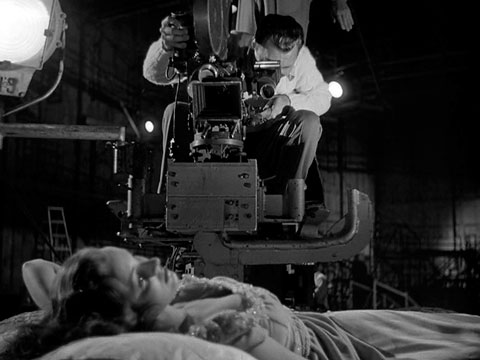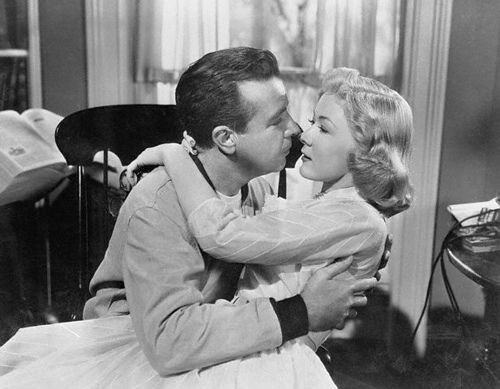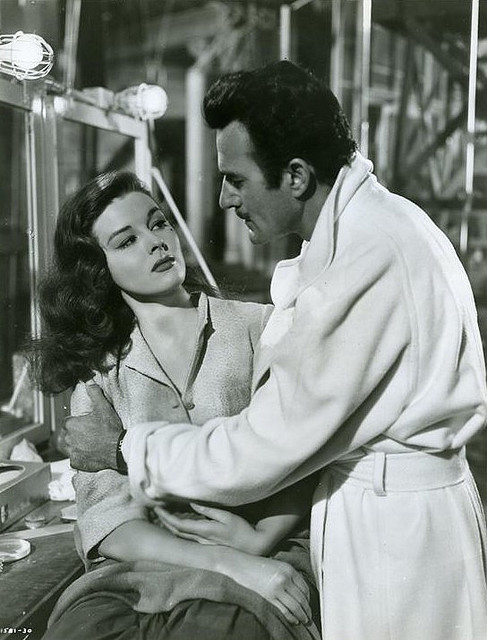In the golden age of the movies that was 1952, The Bad and the Beautiful must have seemed quite a radical attack on the industry. A gorgeous opening sequence suggests that we are to be treated to an unadulterated love letter to the pictures: the camera moves in on a director perched on a huge boom (pictured below) as he swoops down on an intimate scene featuring a prone young actress in a lowcut gown. Then comes a phone call which, when he hears the name, the director refuses to take. The caller, we learn, is Tinseltown’s hottest hotshot producer, now fallen on lean times. A director needs a castiron excuse to blank such an eminence.
 And so it proves. Charles Schnee’s script breaks the narrative into three segments, in each of which Kirk Douglas’s saturnine producer Jonathan Shields is seen to take up and then betray a trusting collaborator: first promising young director Fred Amiel (Barry Sullivan), then beautiful but damaged blonde starlet Georgia Lorrison (Lana Turner) and finally scriptwriter James Lee Bartlow (Dick Powell), a southern novelist lured against his better judgement to Hollywood. Despite the rupture in their relations with Shields, all have gone on to have flourishing careers. It’s only out of courtesy to his old financier Harry Pebbell (Walter Pidgeon) that they agree to meet one night at the old Shields offices, where Oscar statuettes stand in formation on the mantelpiece. On the way in a flighty Turner daubs a moustache on the Shields crest, pompously blazoned with the words “Non Sans Droit”, but her mood darkens when it emerges that Shields, on the end of the phone in Paris, seeks one last favour of all three: to agree to make a picture that will set him back on his feet. And so we spool back 17 years to find out precisely why their compliance is unlikely.
And so it proves. Charles Schnee’s script breaks the narrative into three segments, in each of which Kirk Douglas’s saturnine producer Jonathan Shields is seen to take up and then betray a trusting collaborator: first promising young director Fred Amiel (Barry Sullivan), then beautiful but damaged blonde starlet Georgia Lorrison (Lana Turner) and finally scriptwriter James Lee Bartlow (Dick Powell), a southern novelist lured against his better judgement to Hollywood. Despite the rupture in their relations with Shields, all have gone on to have flourishing careers. It’s only out of courtesy to his old financier Harry Pebbell (Walter Pidgeon) that they agree to meet one night at the old Shields offices, where Oscar statuettes stand in formation on the mantelpiece. On the way in a flighty Turner daubs a moustache on the Shields crest, pompously blazoned with the words “Non Sans Droit”, but her mood darkens when it emerges that Shields, on the end of the phone in Paris, seeks one last favour of all three: to agree to make a picture that will set him back on his feet. And so we spool back 17 years to find out precisely why their compliance is unlikely.
Vincente Minnelli’s portrait of Hollywood in all its naked cynicism, released as part of the BFI’s retrospective, was made when the studio system was still in situ. As Ronald Bergan explains in his introduction to the BFI season for theartsdesk, the director was a one-studio loyalist. His own producer John Houseman presumably felt safe in his relationship with Minnelli, because it was his idea to bring a treatment submitted about the theatre closer to home, and make it about the ethical cavity that is the film industry.
 The tripartite structure is unusual. Essentially a trio of linked short stories, it charts the creeping descent of Shields – played by Douglas in one of his finest performances as a passionate obsessive who moves with seductive, catlike grace – from a venial sinner to something altogether grimmer. The betrayal of Sullivan is the kind of casual con that has happened a thousand times before and since: a director brings in an idea and the producer filches it without a backward glance.
The tripartite structure is unusual. Essentially a trio of linked short stories, it charts the creeping descent of Shields – played by Douglas in one of his finest performances as a passionate obsessive who moves with seductive, catlike grace – from a venial sinner to something altogether grimmer. The betrayal of Sullivan is the kind of casual con that has happened a thousand times before and since: a director brings in an idea and the producer filches it without a backward glance.
The second segment is of a darker hue. Shields, himself the son of an unmourned producer, is convinced that the daughter of a recently deceased great actor can become his muse. The camera may love her, but the trouble is Georgia Lorrison is an unhappy drunk. Shields intuits that the only way he can keep her off the bottle and get a performance out of her is to deceive her with a chillingly plausible display of affection. The gulling of Turner's self-indulgent young sot cleverly flips the idea of the ambitious starlet who opens her legs on the casting couch. Here the producer is the whore. The sequence in which, twinkling in furs on her big opening night, she discovers she has been used is the emotional heart of a film that opts mostly to undercut itself with levity. Douglas howls with self-hatred while Turner heartbreakingly sobs at the wheel as she speeds away from her humiliation.
 If The Bad and the Beautiful has a weaker section, it’s the last. It features a gentle pop at polite southern gentility in the form of Bartlow’s wife Rosemary, played for laughs by Gloria Grahame (pictured above with Dick Powell) as a daffy fun-loving airhead. Her frothy persona doesn’t quite square with the awful fate Schnee’s otherwise pitch-perfect script has in store for her. But along the way there are pleasures aplenty, among them several delightful performances on the supporting card: Sammy White as Turner’s lachrymose agent, Ivan Trisault as a peremptory German director of the old school, Elaine Stewart as a slutty extra who snarls one of the film’s most memorable lines: “There are no great men, buster. Only men.” It’s a mark of the great depth of detail that one of the loveliest cameos comes from a wordless blonde (Lucille Knoch), hired by Shields as bait to lure sultry Latin heartthrob Victor “Gaucho” Ribera (Gilbert Rolland, pictured above right with Elaine Stewart) to grace one of his films. She dances on autopilot until granted a brief window to scoff a late-night plate of grub.
If The Bad and the Beautiful has a weaker section, it’s the last. It features a gentle pop at polite southern gentility in the form of Bartlow’s wife Rosemary, played for laughs by Gloria Grahame (pictured above with Dick Powell) as a daffy fun-loving airhead. Her frothy persona doesn’t quite square with the awful fate Schnee’s otherwise pitch-perfect script has in store for her. But along the way there are pleasures aplenty, among them several delightful performances on the supporting card: Sammy White as Turner’s lachrymose agent, Ivan Trisault as a peremptory German director of the old school, Elaine Stewart as a slutty extra who snarls one of the film’s most memorable lines: “There are no great men, buster. Only men.” It’s a mark of the great depth of detail that one of the loveliest cameos comes from a wordless blonde (Lucille Knoch), hired by Shields as bait to lure sultry Latin heartthrob Victor “Gaucho” Ribera (Gilbert Rolland, pictured above right with Elaine Stewart) to grace one of his films. She dances on autopilot until granted a brief window to scoff a late-night plate of grub.
If this thrilling blend of melodrama and wit has a flaw, it’s that the denouement feels bathetic after such an extensive examination of an industry’s foibles and pitfalls. But that’s to quibble. Minnelli treats us to a masterclass in filmmaking, never better than when Douglas famously explains how to make a dog of a script called Doom of the Cat Men scary by the simple expedient of never showing the cat men. The director can be forgiven for being unable finally to bite off the hand that fed him. Indeed, the delightful final frames perhaps even exonerate Shields, a master storyteller who may be bad but is also, in his devilish way, beautiful.














Add comment